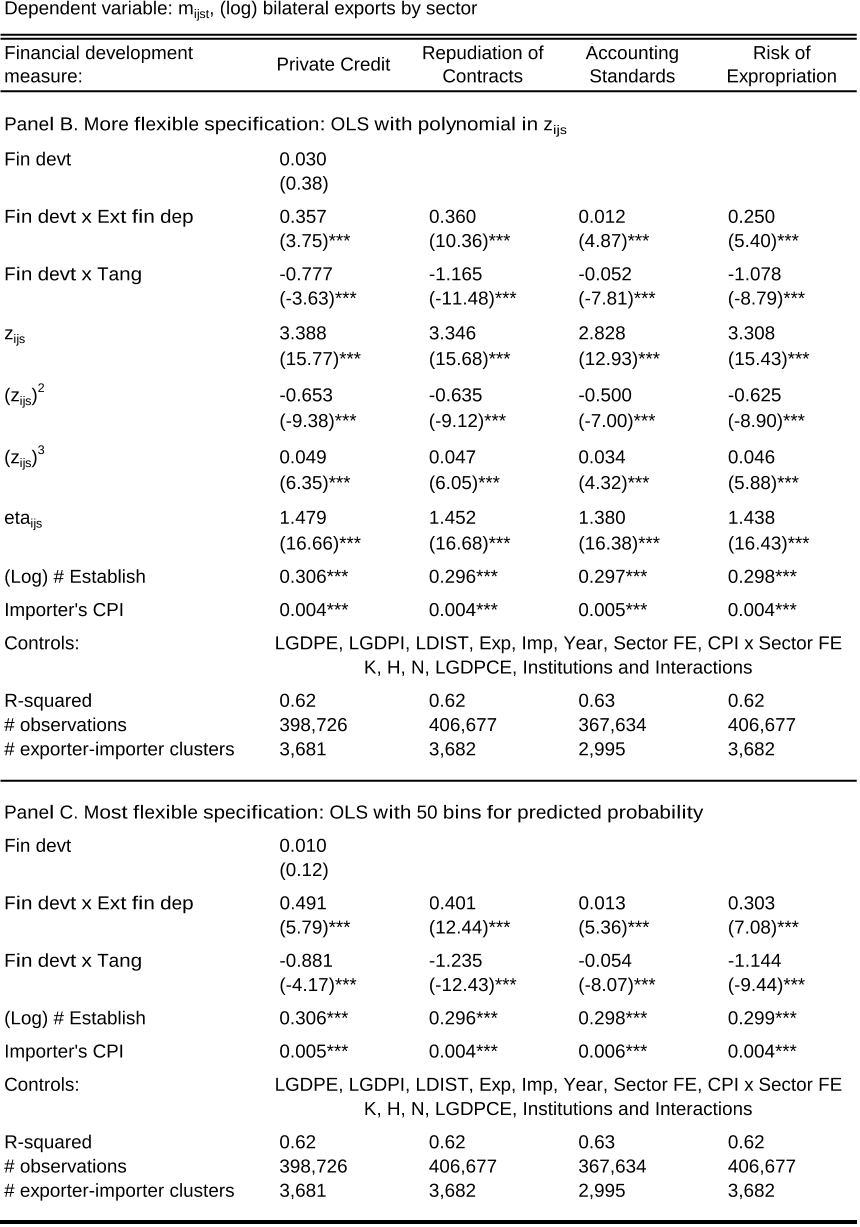Credit Constraints, Heterogeneous Firms and International Trade
Reads0
Chats0
TLDR
This article examined the detrimental consequences of financial market imperfections for international trade and developed a heterogeneous-firm model with countries at different levels of financial development and sectors of varying financial vulnerability.Abstract:
This paper examines the detrimental consequences of financial market imperfections for international trade. I develop a heterogeneous-firm model with countries at different levels of financial development and sectors of varying financial vulnerability. Applying this model to aggregate trade data, I study the mechanisms through which credit constraints operate. First, financial development increases countries' exports above and beyond its impact on overall production. Firm selection into exporting accounts for a third of the trade-specific effect, while two thirds are due to reductions in firm-level exports. Second, financially advanced economies export a wider range of products and their exports experience less product turnover. Finally, while all countries service large destinations, exporters with superior financial institutions have more trading partners and also enter smaller markets. All of these effects are magnified in financially vulnerable sectors. These results have important policy implications for less developed economies that rely on exports for economic growth but suffer from poor financial contractibility.read more
Figures

Table 10. Economic Significance: Predicted vs. Actual Trade Growth 
Table 9. Economic Significance: Comparative Statics 
Table 5. Financial Development and Firm-Level Exports 
Figure 3. The Productivity Cut-off for Exporting 
Table 5. Financial Development and Firm-Level Exports 
Table 1. Export Patterns in the Data
Citations
More filters
Journal ArticleDOI
Adjustment mechanisms of Greek regions in export activity during the economic crisis of 2008–2012
TL;DR: In this paper, a spatial econometric analysis of SUR models is performed to examine the changes that occurred in exports by the (NUTS 3 level) regions for the period 2008-2012 to offer resistance against the crisis and to stimulate growth, which entail expansion of export demand, improvement in the quality of agricultural products, deeper specialization in broad low-technology sectors and simultaneous increases in the variety inside these sectors and the ability of exports to transfer their growth gains to the broader economy.
Journal ArticleDOI
Optimal monetary policy with endogenous export participation
TL;DR: In this paper, the authors consider a two-country dynamic general equilibrium model where firms make decisions to enter and exit the domestic and export markets and show that endogenous export participation creates an incentive for policymakers to set high interest rates.
Journal ArticleDOI
Credit Constraints and FDI Spillovers in China
TL;DR: Li et al. as mentioned in this paper used a panel of approximately 20,000 Chinese manufacturing firms over the period 2001-2005 to show that credit constrained domestic firms have lower (even negative) FDI spillovers, with their reduction in the spillover effect being systematically greater in sectors with higher levels of external financial dependence.
Journal ArticleDOI
The Effects of Political Institutions on the Extensive and Intensive Margins of Trade
TL;DR: In this paper, the authors present a model of political networks that integrates both the choice of trade partners and trade volumes (the intensive margin) and predict that regimes secure in their survival, including democracies as well as some consolidated authoritarian regimes, will trade more on the extensive margin than vulnerable autocracies, which will block trade in products that would expand interpersonal contact among their citizens.
Journal ArticleDOI
Export quality differentiation under credit constraints
Andrea Ciani,Francesca Bartoli +1 more
TL;DR: In this article, the effect of credit constraints on the choice by small and medium-sized enterprises to export goods of higher quality relative to their domestically sold output (quality differentiation) was investigated.
References
More filters
Posted Content
Law and Finance
Rafael La Porta,Rafael La Porta,Florencio Lopez de Silanes,Florencio Lopez de Silanes,Andrei Shleifer,Andrei Shleifer,Robert W. Vishny,Robert W. Vishny +7 more
TL;DR: This paper examined legal rules covering protection of corporate shareholders and creditors, the origin of these rules, and the quality of their enforcement in 49 countries and found that common law countries generally have the best, and French civil law countries the worst, legal protections of investors.
Journal ArticleDOI
Law and Finance
TL;DR: In this article, the authors examined legal rules covering protection of corporate shareholders and creditors, the origin of these rules, and the quality of their enforcement in 49 countries and found that common-law countries generally have the strongest, and French civil law countries the weakest, legal protections of investors, with German- and Scandinavian-civil law countries located in the middle.
Journal ArticleDOI
The Impact of Trade on Intra-Industry Reallocations and Aggregate Industry Productivity
TL;DR: This paper developed a dynamic industry model with heterogeneous firms to analyze the intra-industry effects of international trade and showed how the exposure to trade will induce only the more productive firms to enter the export market (while some less productive firms continue to produce only for the domestic market).
Journal ArticleDOI
Finance and Growth: Schumpeter Might Be Right
TL;DR: In this paper, the authors examined a cross-section of about 80 countries for the period 1960-89 and found that various measures of financial development are strongly associated with both current and later rates of economic growth.
ReportDOI
Financial Dependence and Growth
Raghuram G. Rajan,Raghuram G. Rajan,Raghuram G. Rajan,Luigi Zingales,Luigi Zingales,Luigi Zingales +5 more
TL;DR: This paper examined whether financial development facilitates economic growth by scrutinizing one rationale for such a relationship; that financial development reduces the costs of external finance to firms, and found that industrial sectors that are relatively more in need of foreign finance develop disproportionately faster in countries with more developed financial markets.